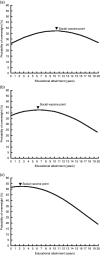Non-linear education gradient across the nutrition transition: mothers' overweight and the population education transition
- PMID: 26054756
- PMCID: PMC4640944
- DOI: 10.1017/S1368980015001640
Non-linear education gradient across the nutrition transition: mothers' overweight and the population education transition
Abstract
Objective: Previous studies found that developed and developing countries present opposite education-overweight gradients but have not considered the dynamics at different levels of national development. An inverted U-shaped curve is hypothesized to best describe the education-overweight association. It is also hypothesized that as the nutrition transition unfolds within nations the shape of education-overweight curve changes.
Design: Multilevel logistic regression was used to estimate the moderating effect of the nutrition transition at the population level on the education-overweight gradient. At the individual level, a non-linear estimate of the education association was used to assess the optimal functional form of the association across the nutrition transition.
Setting: Twenty-two administrations of the Demographic and Health Survey, collected at different time points across the nutrition transition in nine Latin American/Caribbean countries.
Subjects: Mothers of reproductive age (15-49 years) in each administration (n 143 258).
Results: In the pooled sample, a non-linear education gradient on mothers' overweight was found; each additional year of schooling increases the probability of being overweight up to the end of primary schooling, after which each additional year of schooling decreases the probability of overweight. Also, as access to diets high in animal fats and sweeteners increases over time, the curve's critical point moves to lower education levels, the detrimental positive effect of education diminishes, and both occur as the overall risk of overweight increases with greater access to harmful diets.
Conclusions: Both hypotheses were supported. As the nutrition transition progresses, the education-overweight curve shifts steadily to a negative linear association with a higher average risk of overweight; and education, at increasingly lower levels, acts as a 'social vaccine' against increasing risk of overweight. These empirical patterns fit the general 'population education transition' curve hypothesis about how education's influences on health risks are contextualized across population transitions.
Keywords: Education; Latin America; Mother’s overweight; Nutrition transition; Obesity risk; Population education–health curve.
Figures



References
-
- Caballero B (2005) The nutrition transition: global trends in diet and disease. In Modern Nutrition in Health and Disease, pp. 1717–1722 [ME Shils, M Sheke, AC Ross et al.., editors]. Philadelphia, PA: Lippincott Williams & Wilkins.
-
- Filozof C, Gonzalez C, Sereday M et al.. (2001) Obesity prevalence and trends in Latin-American countries. Obes Rev 2, 99–106. - PubMed
-
- Uauy R, Albala C & Kain J (2001) Obesity trends in Latin America: transiting from under- to overweight. J Nutr 131, issue 3, 893S–899S. - PubMed
Publication types
MeSH terms
Grants and funding
LinkOut - more resources
Full Text Sources
Research Materials

